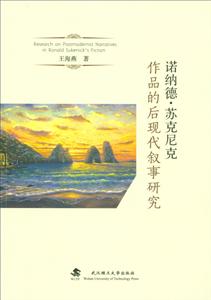诺纳德:苏克尼克作品的后现代叙事研究
节选
[
3.2.2 The Survival of the Novel: Narrative Innovations Under the pressure of survival, fiction is forced to change. The crises of fiction offer great opportunities for fiction innovation, as Suke’nick believes, “if everything is impossible, then anything becomes possible” (Sukenick 2003:8). As we are in a time when all the “paradigms” of fiction are called into question, in consequence we begin to see the development of a poetics of fiction. John Barth, after declaring “the exhaustion of the literature”, also realizes that when the conventions and constraints of discourse fall apart, it is also a time for “the literature replenishment” (65-71). So for the survival of fiction, a group of novelists indulge themselves in a tireless practice of experimental writing. That is what Klinkowitz identifies as a disruptive tendency in American fiction in the 1960s. Such writers as William Burroughs, William Gaddis, John Barth, Thomas Pynchon, Kurt Vonnegut, Donald Barthelme, Ronald Sukenick, Ishmael Reed, Steve Katz, Clarence Majors, Walter Abish and Robert Coover experiment in different ways to challenge the grand narrative of modernism. William Burroughs in his novel Naked Lunch uses fragmentary to replace central narrative arc and employs pastiche to fold in elements from popular genres such as detective fiction and science fiction. Thomas Pynchon in particular provides prime examples of playfulness, often including silly wordplay within a serious context. Intertextuality is another feature displayed in works by Margaret Atwood, Donald Barthelme, John Barth and Robert Coover. Kurt Vonnegut in his novel Slaughterhouse-Five interplays popular science fiction with wartime reportage. In summary, the new styles of narratives possess the characteristics of disjunction, simultaneity, indeterminacy, irrationalism, anti-illusionism, self-reflexiveness, exagger- ated structural patterning, the absence of plot, literary parodies, temporal and spatial dislocations, blurred boundaries of discourse and pastiche, which later are put into the broad category of postmodernism. Ronald Sukenick, after realizing the crises of fiction, starts his narrative innovation from his first novel Up. To him, what an innovative novelist first should do is to deconstruct the conventions of traditional novels. Sukenick points out that “one of the main purposes of really good writing is to destroy other really good writing, to destroy all the old concepts and formulas that come out of the best of the past. You should destroy them lovingly and with great consciousness and awareness of them, but always with the end in mind of getting beyond them again” (qtd. LeClair and McCaffery 1974:282). The title of his most important theoretical essay collection In Form : Digressions on the Act o f Fiction shows his effort to digress from the established and set road of fiction. In this collection, such essays as “Twelve Digressions Toward a Study of Composition”, “Thirteen Digressions”, “Fiction in the Seventies: Ten Digressions on Ten Digressions”, “Eight Digressions on the Politics of the Language”, “Nine Digressions on Narrative Authority”, “Film Digression” and “The Finnegan Digression” present his unremitting efforts in breaking through the constraints of almost every aspect of fiction writing. In doing so, he intends to open up a new space. “It’s like cutting a log in a new direction: a new grain opens up, literally a new content appears when you cut something in a new way from the way it usually gets cut. You see different things; words then begin to surrender their meanings in different ways and begin to reveal all that huge amount of accumulated wisdom that language contains from the whole history of the culture” (qtd. LeClair and McCaffery 1974:283). ……
]
内容简介
[
《诺纳德·苏克尼克作品的后现代叙事研究》是从一个全新的视角评释苏克尼克和他的小说, 指出他在上世纪60年代美国小说危机和身份危机双重困境中努力进行叙事改革, 采用生存法则、“熵”的法则和镶嵌法则来应对, 从而深入揭示这位不平凡的小说家、文论家、批评家、编辑、出版商和教育家对美国文学的重要贡献。
]
目录
Chapter 1 Introduction1.1 A Mosaic Man of Literature: Ronald Sukenick and His Literary Career1.2 Ronald Sukenick Studies in the United States and China1.3 The Aim and Structure of This BookChapter 2 Identity and Identity Study in the Postmodern Context2.1 Identity: From Modernism to Postmodernism2.1.1 Definition of Identity2.1.2 Identity in Modern Context2.1.3 Identity in Postmodern Context2.2 Identity in Postmodernist Narratives2.2.1 Identity in Narratives2.2.2 Identity in Postmodernist NarrativesChapter 3 Surviving Law:Assimilation or Dissimilation3.1 Surviving Law of Identity in Up and Down and In : Life in the Underground3.1.1 Surviving Law of Identity I : Assimilating into American Mainstream3.1.2 Surviving Law of Identity II : Dissimilating into American Mainstream3.1.3 Mainstream and Anti-mainstream: Struggling between Assimilation and Dissimilation3.2 Surviving Law of Postmodernist Narratives3.2.1 Death of the Novel3.2.2 The Survival of the Novel: Narrative InnovationsChapter 4 Entropy Law:Fluidity and Dissolution4.1 Entropy Law of Identity in Out and 98.64.1.1 Stream of Identities4.1.2 Non-identity4.2 Entropy Law of Postmodernist Narratives4.2.1 Typographic innovations4.2.2 Language PlayChapter 5 Mosaic Law:Fragmentation and Collage5.1 Mosaic Law of Identity in 98.6 and Mosaic Man5.1.1 Cultural Shards and Hybridity5.1.2 Psychosynthesis vs. Psychoanalysis5.2 Mosaic Law of Postmodernist Narratives5.2.1 Patchwork5.2.2 CollageChapter 6 ConclusionReferences
封面

书名:诺纳德:苏克尼克作品的后现代叙事研究
作者:王海燕著
页数:18,126页
定价:¥58.0
出版社:武汉理工大学出版社
出版日期:2017-09-01
ISBN:9787562955825
PDF电子书大小:42MB 高清扫描完整版
